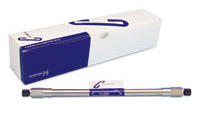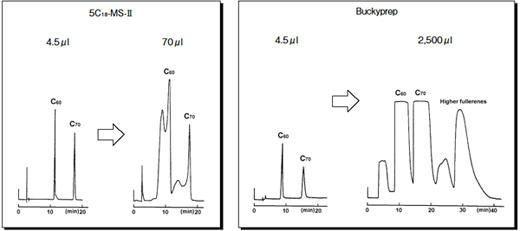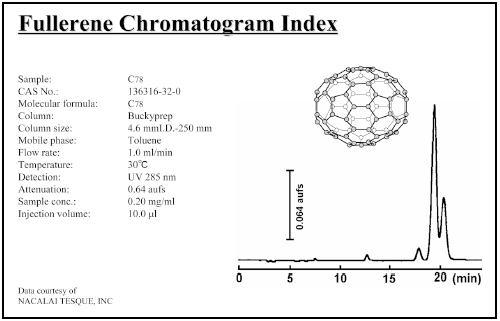Fullerene Separation Columns

Separation of fullerenes, especially preparative scale separation, on conventional HPLC columns are always problematic due to the low solubility and low recovery rate of fullerenes. COSMOSIL offers a variety of columns designed for preparative scale separation of fullerenes including higher fullerenes, metallofullerenes and fullerene derivatives.
Specifications
| Packing material | Buckyprep | Buckyprep-M | PBB | PYE | NPE |
|---|---|---|---|---|---|
| Silica gel | High Purity Porous Spherical Silica | ||||
| Average particle size | 5 µm | ||||
| Average pore size | approx. 120 | ||||
| Specific surface area | approx. 300 m2/g | ||||
| Stationary phase |  Pyrenylpropyl group |
 Phenothiazinyl group |
 Pentabromobenzyl group |
 Pyrenylethyl group |
 Nitrophenylethyl group |
| Bonding type | Monomeric | ||||
| End capping treatment | Near-perfect | None | Near-perfect | ||
| Carbon content | approx. 17% | approx. 13% | approx. 8% | approx. 18% | approx. 9% |
| Features | Standard column for fullerenes separation. | Designed to separate metallofullerenes. | Designed for preparative separation of C60, C70. | Separation of fullerene and structural isomers. | Separation of fullerene derivatives |
Product Informations
Comparison of retention in toluene
The figure below shows the retention time of C60 and C70 in toluene. Buckyprep, Buckyprep-M and PBB, and PYE nicely separate C60 and C70. On the other hand, C18 with alkyl group and NPE can not separate them in toluene.

| Condition | |||||
|---|---|---|---|---|---|
| Column size | 4.6 mm I.D. x 150 mm | Column | k' C60 | k' C70 | αC70/C60 |
| Mobile phase | Toluene | PBB | 2.22 | 5.43 | 2.44 |
| Flow rate | 1.0 ml/min | Buckyprep | 1.54 | 3.09 | 2.00 |
| Temperature | 30°C | Buckyprep-M | 1.12 | 1.79 | 1.59 |
| Detection | UV 312 nm | PYE | 0.71 | 1.46 | 2.06 |
| Sample | 1. C60 | NPE | 0.07 | 0.09 | 1.40 |
| 2. C70 | 5C18-MS-II | 0.00 | 0.00 | 1.00 | |
Solubility and boiling point of each solvent for C60
| Solvent | mg/ml | b.p. (°C) |
|---|---|---|
| Methanol | 0.001 | 64.5 |
| Acetonitrile | 0.018 | 81.8 |
| n-Hexane | 0.046 | 68.7 |
| Toluene | 3.2 | 111 |
| Chlorobenzene※ | 7.0 | 132 |
| Carbon Disulfide | 12 | 46.3 |
| o-Dichlorobenzene※ | 27 | 180 |
| 1,2,4-Trichlorobenzene | 21.3 | 213 |
※ R. S. Ruoff, et al., J. Phy. Chem., 97, 3379 (1993)
The table above shows solubility and boiling point of each solvent for C60. Toluene is the most suitable solvent for due to its high solubility, appropriate boiling point, low cost and low corrosivity. Although C18 columns with alkyl groups can not separate C60 and C70 in toluene, by mixing acetonitrile and toluene, they can be separated as shown in the figure below. However, increasing injection volume in preparative purification triggers tailing that results in a practical injection volume limit of only 70 µl (175 µg). On the other hand, Buckyprep can separate well in toluene with no tailing with a maximum injection volume of 2,500 µl (6.25 mg).
Comparison with C18

| Condition | |
|---|---|
| Column size | 4.6 mm I.D. x 250 mm |
| Mobile phase | [5C18-MS-II] Toluene : acetonitrile = 55 : 45 |
| [Buckyprep] Toluene | |
| Flow rate | 1.0 ml/min |
| Temperature | 30°C |
| Detection | UV 285 nm |
| Sample | Fullerene toluene extract (2.5 mg/ml) |
Suggested solvents
| Solvents usable with Buckyprep series | ||
|---|---|---|
| Solvent | Features | C60 Solubility (mg/ml) |
| Toluene | General-use solvent for fullerenes. | 3.2 |
| n-Hexane | Weaker eluent than toluene. | 0.046 |
| n-Heptane | ** | |
| Methanol | 0.001 | |
| 2-Propanol | ** | |
| Acetonitrile | Weaker eluent than toluene. |
0.018 |
| Chlorobenzene | Stronger eluent than toluene. | 7 |
| o-Dichlorobenzene | Stronger eluent than chlorobenzene. | 27 |
| 1,2,4-Trichlorobenzene | Strongest commonly-used eluent. Can be used to flush higher fullerenes. | 21.3 |
Note: Use after filtration or distillation, if they are not HPLC grade.
Except for alkali aqueous and strong acid solutions, other solvents can be used (e.g., water-free pyridine and others). Depending on solvents, pay attention to high pressure caused by high solvent viscosity.
Applications
Fullerene Chromatogram Index
Fullerene Chromatogram Index includes more than 100 chromatograms is available at the website of The Fullerenes, Nanotubes and Graphene Research Society. (Click here to download)










